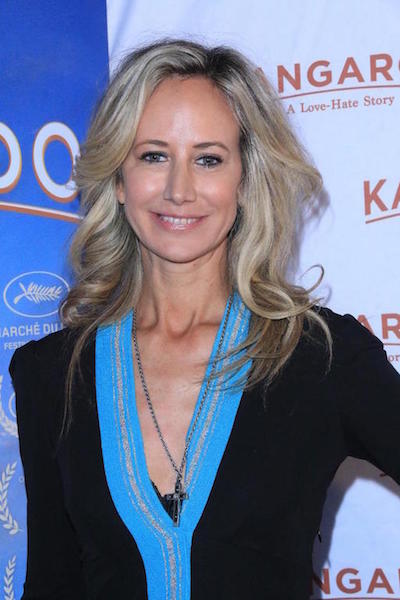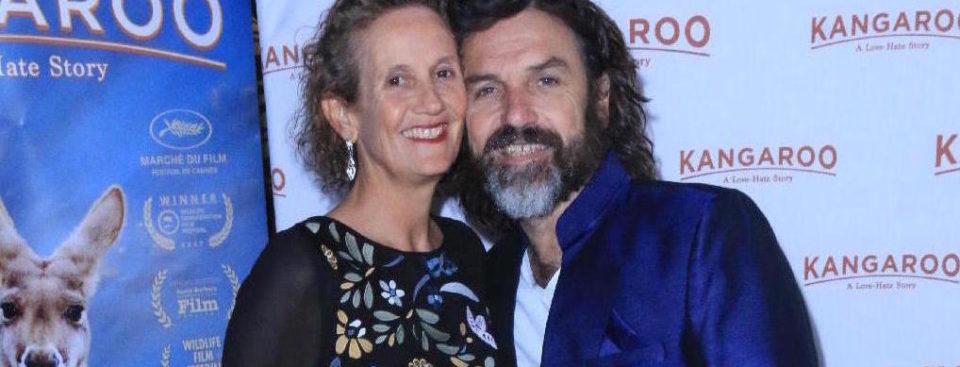
Kangaroo: A Love-Hate Story panel discussion. From left to right: Jenny Cooney, Kate McIntyre Clere, Mick McIntyre and Jennifer Fearing
Beverly Hills, (LA ELEMENTS) 02-02-2018 – “It was really hard. It was the hardest film I ever made. There is a different thinking out there in the bush. And so us city folk, coming out to try and tell a story that they were very suspicious of, it was very challenging,” says Mick McIntyre director of the shocking documentary, Kangaroo: A Love-Hate Story. “We tried to be as genuine as we could when talking to them. We tried to just explain that their story was part of what we were trying to tell. It was hard.”
The Los Angeles film premiere of Kangaroo: A Love-Hate Story, was held on January 23, 2018, at the Laemmle Music Hall Theater in Beverly Hills, CA. Produced and directed by husband and wife team Mick McIntyre and Kate McIntyre Clere, this film offers a harrowing look at the barbaric treatment of the Australian icon, the kangaroo.

Lady Victoria Hervey attends the Los Angeles premiere of Kangaroo: A Love-Hate Story.
Following the screening, a Q&A was moderated by Jenny Cooney, a member of the Hollywood Foreign Press, Australia. The panel consisted of the filmmakers, Mick McIntyre and Kate McIntyre Clere, and Jennifer Fearing, Legislative Advocate for Humane Society of The United States who is also featured in the film. A VIP reception was held at the vegan restaurant Gratitude Beverly Hills.
Kangaroo: A Love/Hate Story, allows the viewer to follow the journey of the kangaroo from its natural habitat, to the killings in the outback, the meat processing plants and the retail sales of the kangaroo products, while holding nothing back in the process. Indeed, footage of hunters in the dark of night slaughtering kangaroos and tearing their babies from the pouches, elicited some of the strongest reactions from audience members.
While meat from the kangaroos is used for both pet and human consumption, this documentary reveals that tests of kangaroo meat purchased in grocery stores contain levels of e-coli and salmonella bacteria that in the US would cost millions in lawsuits. Yet in Australia, the unsanitary storage and sale of unsafe meat are swept under the rug for profits. The average Australian citizen is unaware of what is going on within his or her own country.
The film features interviews with people on all sides of the issue, from a former kangaroo hunter to scientists, politicians and animal activists trying to protect the species. In one of the first interviews with scientists, Kate McIntyre Clere discovered this is the largest destruction of mammals on the planet at the moment. “We were kind of shattered after that. We realized there is a lot to this story,” says McIntyre Clere.
During the Q&A, Fearing generated cheers from the audience when she shared that California was the only state that had a ban on the import and sale of kangaroo products. When asked what is going on locally with the issue, Fearing says, “I am far from an expert on kangaroos and more of an expert on the shenanigans in Sacramento. So unfortunately, I think the threat remains imminent. Part of our challenge is telling the story about an animal far, far away where people don’t understand the circumstances. They assume that the standard for species protection or measurement or population management of wildlife, bears any resemblance for all of its laws to the American or California sort of way of managing and counting wildlife. They assume the Australians have anything similar to that, when in fact they don’t. So it is a real challenge to us to tell their story. I think this film can make an extraordinary difference. We have to be super vigilant with educational tools like this film. We have to drag members of the legislature and their staff to see it. The almighty dollar is a real challenge for us to overcome.” Although the ban is still in effect in California, powerful lobbyists continue to use their clout to sway the California legislators to lift it.
During the Q and A, McIntyre Clere noted critical actions, which must be taken to save the kangaroo, Australia’s most renowned ambassador. “It is an international subject. I think that just because they were not on the (endangered) list before like the seals and elephants and whales, they are international animals. They are the largest marsupial species left on the planet. This is our planet. I think we need to step forward and put the kangaroos on that list. They may not have that kind of status on the international stage, but why not start?.”
Fearing emphasized the importance of remaining watchful. “You heard them talk about the volumes they need to kill in order to meet that demand. That demand dries up when the buying stops and then the killing does too. I think that is the opportunity we have, where we are, to put pressure on Australia, to shame Australia unfortunately, for having treated their iconic animal this way.”
We had the opportunity to speak to Kate McIntyre Clere in a one-on-one interview after the screening, where she revealed more about the hard work that went into the making of her film.
What inspired you to make Kangaroo: A Love-Hate Story?
“We were looking at making a celebration of the kangaroo, which is just the most amazing, unusual symbol of Australia, recognized all over the world as one of the top icons, just like the Eifel Tower and Statue of Liberty. Everyone knows it. So we thought it was fantastic, but found it was divisive in Australian culture. Some people love it, some people hate it. For some people, it is very spiritual and sacred. So it was an interesting story: a nation divided.”
How many years ago did you start on the film?
“We started about four years ago off and on. We make a few films at a time. So there’s a lot going on in Australia as you can imagine. It’s a big country, so it takes a while to get from place to place.”
Does the average person in Australia have any idea what is going on?
“As you can imagine, most people in the cities have never even seen a kangaroo. Even in the summer, we drove a ten hour drive from our house and didn’t see one kangaroo. On the coast and in the populated areas, we are not even seeing them. Also, the general media response to kangaroos is pests. They are always targeting them as a pest. And so I think over the years when that is your media, you just think of it as true.”
Do you plan on getting involved politically with the issue?
“No. Not really. I think there are a lot of really great people in Australia that once they see the film will make the voice for social change. For us, I feel we’ve done our bit. We are storytellers and saw a story that needed telling. Hopefully, like you tonight, you sort of see what happens and you go and make up your own mind. I think most Australians will learn new things. Some of them will know bits and pieces, but I certainly didn’t. I love the environment and love celebrating animals and I didn’t know any of this. Many Australians think they (kangaroos) are farmed. Which I think is a particular way that we see some things can be farmed and that’s okay. Actually kangaroo are wildlife. They are not farmed. They are not reproduced. We can’t make the numbers, so it is a very different thing trying to commercialize wildlife.
How could they let the kangaroo meat with salmonella and e-coli out on the market for human consumption?
“It’s interesting, isn’t it? I think historically, it was for pet food and farmers took the opportunity when the kangaroos were killed on their property to use it for their dogs and stuff. I don’t know where the legislation came from for cleanliness. Obviously, some scientists are very concerned about that.”
In our country, if it came out on a show like Dateline that our meat had those levels of salmonella and e-coli, people would be freaking out.
“I think most Australians don’t know that.”
Have you eaten kangaroo meat?
“No. I’m not a game type meat person. I have a family and we just eat humanely when we can. I think if people want to support us, they can go to www.kangaroothemovie.com. We are playing around the country in 20 cities coming up. We are in Portland on Thursday and keep moving around. Mick and I are going to be at the first month of screenings and we love to talk to people and see them there. They are usually event screenings, so make sure you jump on quickly because they hopefully sell out with a lot of discussion at each event.”
When do you go back home?
“The kids actually finish their summer vacation in a few weeks.”
The filmmakers will return to their homeland to present the film in March. They have already been bombarded with comments on social media from people on both sides of the issue, so they are anticipating polarizing opinions regarding the fight for justice for the kangaroo when the film opens in Australia next month.
For more information on Kangaroo: A Love-Hate Story, please visit their site.
Cover photo of Kate McIntyre Clere and Mick McIntyre and all other photography courtesy of Bob Delgadillo.
Follow LA Elements on Twitter and Instagram. Like us on Facebook.




No Comments